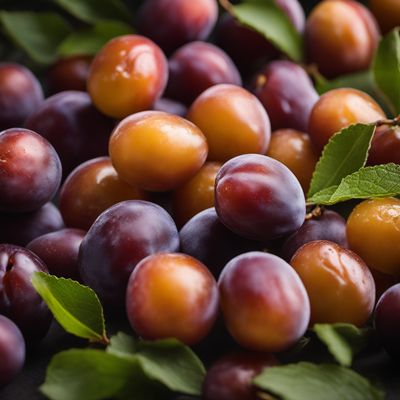
Ingredient
Chinese jujubes
The Ancient Fruit: Chinese Jujubes
Chinese jujubes are small, round fruits with a wrinkled skin that ranges in color from light red to dark brown. They have a sweet and slightly tangy taste, similar to dates, with a chewy texture. The flesh is juicy and surrounds a small seed in the center. Chinese jujubes are often dried to enhance their sweetness and shelf life.
Origins and history
Chinese jujubes have a long history in China and are believed to have been cultivated for over 4,000 years. They hold great cultural significance and are often associated with good luck and prosperity. In traditional Chinese medicine, jujubes are used to improve digestion, boost energy, and promote relaxation. They are also a popular ingredient in various Chinese dishes, such as soups, desserts, and teas.
Nutritional information
Chinese jujubes are a good source of dietary fiber, vitamin C, and antioxidants. They also contain minerals like potassium and iron. These fruits are low in calories and fat, making them a healthy addition to a balanced diet.
Allergens
Chinese jujubes do not contain any known allergens.
How to select
When selecting Chinese jujubes, look for fruits that are plump, firm, and free from blemishes or mold. The skin should be smooth and shiny. Dried jujubes should be soft and slightly wrinkled, indicating that they have been properly dried. Avoid fruits that are overly dry or hard.
Storage recommendations
Fresh Chinese jujubes should be stored in the refrigerator to maintain their freshness. Dried jujubes can be stored in an airtight container in a cool, dark place. Proper storage will help preserve their flavor and texture for an extended period.
How to produce
Chinese jujubes can be grown in home gardens, provided the climate is suitable. They require full sun and well-drained soil. The trees are relatively easy to care for and can be propagated through seeds or cuttings. However, it may take several years for the tree to bear fruit.
Preparation tips
Chinese jujubes can be enjoyed fresh as a snack or used in various culinary preparations. They can be added to soups, stews, and porridges for a natural sweetness. Dried jujubes are often used in desserts, teas, and herbal infusions. They can also be rehydrated and used in baking or as a topping for oatmeal and yogurt.
Substitutions
Dates, raisins, or prunes can be used as substitutes for Chinese jujubes. While they may not have the exact same flavor and texture, they can provide a similar sweetness and chewiness to dishes.
Culinary uses
Chinese jujubes are commonly used in Chinese cuisine, particularly in soups, desserts, and teas. They are also popular in other Asian cuisines, such as Korean and Vietnamese. Jujube tea, made by steeping dried jujubes in hot water, is a common beverage in many cultures.
Availability
Chinese jujubes are primarily cultivated in China, Korea, and other East Asian countries. They are also grown in some parts of the United States, including California.
More ingredients from this category » Browse all

Gages
The Sweet and Succulent Delight: Exploring the World of Gages

Klamath plums
The Jewel of Klamath

Mirabelles
The Golden Gems of Summer

American plums
The Sweet and Tart Delight: Exploring the World of American Plums

Beach plums
The Hidden Gems of the Shoreline: Exploring the Delights of Beach Plums

Cherry plums
The Sweet and Tangy Delight: Exploring the World of Cherry Plums

Sloes
The Bitter-Sweet Berry

Chickasaw plums
The Sweet Gems of the South

Plumcots
The Perfect Blend: Exploring the Unique Delights of Plumcots

Prunus Nadia®
The Exquisite Fusion of Sweetness and Tartness: Prunus Nadia®

Plums
The Juicy Gems

Japanese plums
The Delicate Delights of Ume: Unveiling the World of Japanese Plums
Recipes using Chinese jujubes

Yaksik: Sweet and Nutty Korean Rice Cake
Heavenly Delights: A Sweet Symphony of Korean Rice Cake

Manchu-style Spiced Ginger Cake
Imperial Ginger Delight: A Manchu Twist on Spiced Cake

Korean Ginseng Chicken Soup
Healing Harmony: Korean Ginseng Chicken Soup

Huaiyang-style Stippgrütze
Silky Smooth Huaiyang-style Stippgrütze: A Fusion of German and Chinese Flavors

Korean-Style Chicken Soup
Soothing Samgyetang: Korean Chicken Soup with a Twist

Chinese Buddhist Krumkake
Enlightened Lotus Krumkake: A Delicate Fusion of Norwegian and Chinese Buddhist Flavors

Korean Ginseng Rice Porridge
Soul-Warming Ginseng Rice Porridge: A Korean Delight